Once again, we are delighted to have Ashur present another fascinating blog post on the beauty and wonder of the invertebrates around us, and the texts that can help you get to know and respect them more!
Greetings again dear readers! A couple of weeks ago we (very broadly) featured marine invertebrates; today, we turn our attention to terrestrial invertebrates. I’ve narrowed it to “multicellular/non-microscopic terrestrial invertebrates”, as single-celled organisms will be visited in another entry. Once again, consider this a shamefully brief highlight reel, as logistics unfortunately do not allow me to give these creatures the books-worth of blog attention they deserve.
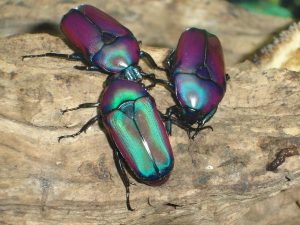
“Terrestrial invertebrates” largely means insects, arachnids (spiders) and perhaps the most-maligned category of invertebrates this side of viruses, bacteria and parasites that cause disease. However, it also includes certain “charismatic” insects such as butterflies, lady bird beetles (or “ladybugs”), dragonflies, scarab beetles, and the the invertebrate poster child for insect concern, the bees. But why do we have such visceral reactions to invertebrates, especially when it comes to physically touching them? And why are some people completely taken with them? One of the books I profile (The Infested Mind) below goes into this in great detail; for now, here is an interview with the author, Jeffrey Lockwood, in Popular Science.
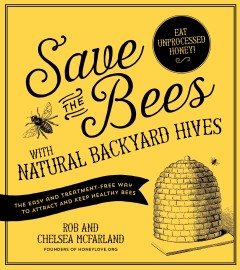 Returning to the topic of bees, if you’ve seen any of the popular campaigns dedicated to (honey)bee preservation, perhaps you’ve wondered why they’re endangered. The answer is somewhat complex, but can be boiled down to colony collapse disorder, parasites, other insects that are destructive to honeycombs, viruses, poor nutrition and pesticide effects. The natural diet of bees comes from a wide variety of flowers. In situations where the hives are being kept in mono-crop growing areas (places where only one type of plant is being grown) for their pollination services, bees’ diet is less nutritious, leading to an overall weakening of bees’ immune systems, which in turn causes them to be more susceptible to some of the threats listed before. Bees are a key link in agricultural systems, so the stakes are high. If the plight of bees strikes a chord within you and you feel moved to do something, you may want to check out this book by Rob and Chelsea McFarland, focusing on urban beekeeping (pictured at left).
Returning to the topic of bees, if you’ve seen any of the popular campaigns dedicated to (honey)bee preservation, perhaps you’ve wondered why they’re endangered. The answer is somewhat complex, but can be boiled down to colony collapse disorder, parasites, other insects that are destructive to honeycombs, viruses, poor nutrition and pesticide effects. The natural diet of bees comes from a wide variety of flowers. In situations where the hives are being kept in mono-crop growing areas (places where only one type of plant is being grown) for their pollination services, bees’ diet is less nutritious, leading to an overall weakening of bees’ immune systems, which in turn causes them to be more susceptible to some of the threats listed before. Bees are a key link in agricultural systems, so the stakes are high. If the plight of bees strikes a chord within you and you feel moved to do something, you may want to check out this book by Rob and Chelsea McFarland, focusing on urban beekeeping (pictured at left).
Finally, it’s worth noting that bees don’t deserve our attention only for the key role they play agriculture (for humans) and flora in general (for everything else); they’re able to coordinate their activities and communicate through dance and vibration and of course, their ability to both play soccer and to teach other bees how to play soccer too.
Pivoting from bees, consider the creatures who’ve generously provided the soundtrack of many a summer (depending on your location, of course): the cicada. Luckily for us, Dan Mozgai runs the definitive all-things-cicada-website: Cicadamania. Mozgai’s site includes regularly-updated sightings and maps for when and a where a brood will be or is emerging, so you can easily see if you’ll soon be hearing their high-pitched whine off of local trees.
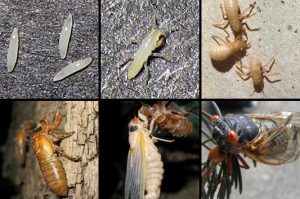
Photo is from www.cicadamania.com
It seems we always circle around towards the actions and habits of Charles Darwin. While I cannot say if this is standard practice for entomologists in this day and age, Darwin was known to store specimens in his mouth so they couldn’t escape if his hands were otherwise occupied, possibly with more specimens. Unfortunately, he once did this with a bombardier beetle, a type known for their ability to expel a noxious hot liquid as defense. Observe:
“The Bombardier Beetle and Its Crazy Chemical Cannon”, by Deep Look. KQED San Francisco and PBS Digital Studios.
But no pursuit at Cambridge was followed with nearly so much eagerness or gave me so much pleasure as collecting beetles. It was the mere passion for collecting; for I did not dissect them, and rarely compared their external characters with published descriptions, but got them named anyhow. I will give a proof of my zeal: one day, on tearing off some old bark, I saw two rare beetles, and seized one in each hand; then I saw a third and new kind, which I could not bear to lose, so that I popped the one which I held in my right hand into my mouth. Alas! it ejected some intensely acrid fluid, which burnt my tongue so that I was forced to spit the beetle out, which was lost, as was the third one.
(Autobiography (Darwin, F., 1887; Vol. 1: 50) Darwin Online)
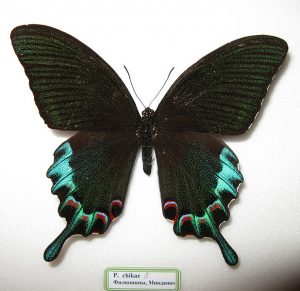
Image taken by Anaxibia, Wikimedia Commons
While perhaps not comparable to Darwin’s beetle-collecting fervor, some insects are so sought-after that there exists black market trafficking of them. Out of the two major categories (fauna and flora) listed on the Convention of International Trade in Endangered Species of Wild Flora and Fauna (CITES) website (which regulates international trade of flora and fauna), invertebrates are by far the largest group represented in the “fauna” category. While their reasons for endangered or threatened status (and degree to which they’re endangered) varies, certain species of invertebrates can and are indeed being poached by a variety of actors, as this article details. In 2017, Chinese courts convicted and fined a ring of butterfly smugglers engaged in the trade of such species as the Luzon peacock swallowtail, which can fetch prices upwards of $1,500 US. Stag beetle keeping (and fighting) is a popular pastime among some in Japan that’s largely practiced DIY-style (catch your own beetles!), but desire for rarer beetles has resulted in poaching, smuggling and consumers willing to pay inflated figures for particular specimens.
http://youtu.be/boaqmHv2gi8
Have you ever felt a need to see a stag beetle bout in the streets? Click to fulfill that goal.
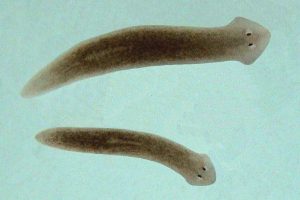
Image: http://isciencemag.co.uk/blog/pet-planarians-they-dont-die/
Before we go to our books, I didn’t want to let insects hog the limelight entirely in this post, this breaking news about adult pluripotent stem cells in planarians was reported this week; in slightly older news, planarians are also allegedly invading France.
Planarians are flatworms that live both in water and on land. In addition to being cute in my opinion, they have been described as immortal: cut off a piece of a planarian and it will regenerate. Moreover, the piece of the planarian that you cut off will also generate into a new planarian. As you can see, they’re very cost effective if you wish to create your own army/society of them.
On that note, let’s take a look at today’s book recommendations for readers needing more invertebrate information in their lives, a description which applies to more people than it does not.
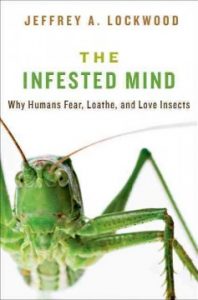 The Infested Mind: Why Humans Fear, Loathe and Love Insects, by Jeffrey Lockwood: The human reaction to insects is neither purely biological nor simply cultural. And no one reacts to insects with indifference. Insects frighten, disgust and fascinate us. Jeff Lockwood explores this phenomenon through evolutionary science, human history, and contemporary psychology, as well as a debilitating bout with entomophobia in his work as an entomologist. Exploring the nature of anxiety and phobia, Lockwood explores the lively debate about how much of our fear of insects can be attributed to ancestral predisposition for our own survival and how much is learned through individual experiences. Drawing on vivid case studies, Lockwood explains how insects have come to infest our minds in sometimes devastating ways and supersede even the most rational understanding of the benefits these creatures provide. Dr. Lockwood has also authored a number of other books about insects, including Locust: The Devastating Rise and Mysterious Disappearance of the Insect that Shaped the American Frontier and Six-Legged Soldiers: Using Insects as Weapons of War.
The Infested Mind: Why Humans Fear, Loathe and Love Insects, by Jeffrey Lockwood: The human reaction to insects is neither purely biological nor simply cultural. And no one reacts to insects with indifference. Insects frighten, disgust and fascinate us. Jeff Lockwood explores this phenomenon through evolutionary science, human history, and contemporary psychology, as well as a debilitating bout with entomophobia in his work as an entomologist. Exploring the nature of anxiety and phobia, Lockwood explores the lively debate about how much of our fear of insects can be attributed to ancestral predisposition for our own survival and how much is learned through individual experiences. Drawing on vivid case studies, Lockwood explains how insects have come to infest our minds in sometimes devastating ways and supersede even the most rational understanding of the benefits these creatures provide. Dr. Lockwood has also authored a number of other books about insects, including Locust: The Devastating Rise and Mysterious Disappearance of the Insect that Shaped the American Frontier and Six-Legged Soldiers: Using Insects as Weapons of War.
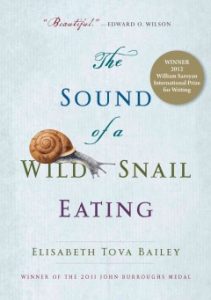 The Sound of a Wild Snail Eating, by Elisabeth Tova Bailey: In a work that beautifully demonstrates the rewards of closely observing nature, Elisabeth Tova Bailey shares an inspiring and intimate story of her encounter with a Neohelix albolabris-a common woodland snail. While an illness keeps her bedridden, Bailey watches a wild snail that has taken up residence on her nightstand. As a result, she discovers the solace and sense of wonder that this mysterious creature brings and comes to a greater understanding of her own place in the world. Intrigued by the snail’s molluscan anatomy, cryptic defenses, clear decision making, hydraulic locomotion, and courtship activities, Bailey becomes an astute and amused observer, offering a candid and engaging look into the curious life of this underappreciated small animal.The Sound of a Wild Snail Eating is a remarkable journey of survival and resilience, showing us how a small part of the natural world can illuminate our own human existence, while providing an appreciation of what it means to be fully alive. Winner of the 2010 John Burroughs Medal, the 2010 National Outdoor Book Award (Natural History Literature category) and the 2012 William Saroyan International Prize for Writing ( and the non-fiction category).
The Sound of a Wild Snail Eating, by Elisabeth Tova Bailey: In a work that beautifully demonstrates the rewards of closely observing nature, Elisabeth Tova Bailey shares an inspiring and intimate story of her encounter with a Neohelix albolabris-a common woodland snail. While an illness keeps her bedridden, Bailey watches a wild snail that has taken up residence on her nightstand. As a result, she discovers the solace and sense of wonder that this mysterious creature brings and comes to a greater understanding of her own place in the world. Intrigued by the snail’s molluscan anatomy, cryptic defenses, clear decision making, hydraulic locomotion, and courtship activities, Bailey becomes an astute and amused observer, offering a candid and engaging look into the curious life of this underappreciated small animal.The Sound of a Wild Snail Eating is a remarkable journey of survival and resilience, showing us how a small part of the natural world can illuminate our own human existence, while providing an appreciation of what it means to be fully alive. Winner of the 2010 John Burroughs Medal, the 2010 National Outdoor Book Award (Natural History Literature category) and the 2012 William Saroyan International Prize for Writing ( and the non-fiction category).
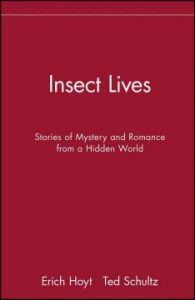 Insect Lives: Stories of Mystery and Romance from a Hidden World, by Erich Hott & Ted Schultz offers an entertaining and informative survey of the human fascination, dreadful and otherwise, with insects diabolical and divine, from accounts in the Bible and Aristotle to the writings of Charles Darwin and the great nineteenth-century naturalists sending home accounts from the rain forest. Highlighted here are observations from E. O. Wilson, Jean-Henri Fabré, David Quammen, May Berenbaum, Roger Swain, William Wordsworth, A. S. Byatt, Gary Larson and more than sixty other writers who tell of the mystery and romance of that other, hidden world beneath our feet and beyond our rolled-up newspapers.
Insect Lives: Stories of Mystery and Romance from a Hidden World, by Erich Hott & Ted Schultz offers an entertaining and informative survey of the human fascination, dreadful and otherwise, with insects diabolical and divine, from accounts in the Bible and Aristotle to the writings of Charles Darwin and the great nineteenth-century naturalists sending home accounts from the rain forest. Highlighted here are observations from E. O. Wilson, Jean-Henri Fabré, David Quammen, May Berenbaum, Roger Swain, William Wordsworth, A. S. Byatt, Gary Larson and more than sixty other writers who tell of the mystery and romance of that other, hidden world beneath our feet and beyond our rolled-up newspapers.
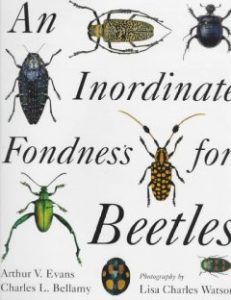 An Inordinate Fondness for Beetles, by Arthur V. Evans and Charles L. Bellamy: Do you like pictures! Here is the beetle book you’ve been waiting for, even if you didn’t know you were! An Inordinate Fondness for Beetles is an authoritative reference in a breathtakingly beautiful volume, one that will leave every reader with a deeper understanding, appreciation, and–yes–fondness for these amazing creatures and their place in nature. In terms of numbers, beetles are the most successful creatures on earth: about 350,000 species of beetles have been described since 1758. They range from tiny to gigantic, occupy sundry habitats, and eat everything–plants, animals, and their own remains. And, as this book beautifully demonstrates, the aesthetics of beetle design are amazing. The fantastic colors and shapes of these creatures warrant the gorgeous color photography lavished on them in this book.
An Inordinate Fondness for Beetles, by Arthur V. Evans and Charles L. Bellamy: Do you like pictures! Here is the beetle book you’ve been waiting for, even if you didn’t know you were! An Inordinate Fondness for Beetles is an authoritative reference in a breathtakingly beautiful volume, one that will leave every reader with a deeper understanding, appreciation, and–yes–fondness for these amazing creatures and their place in nature. In terms of numbers, beetles are the most successful creatures on earth: about 350,000 species of beetles have been described since 1758. They range from tiny to gigantic, occupy sundry habitats, and eat everything–plants, animals, and their own remains. And, as this book beautifully demonstrates, the aesthetics of beetle design are amazing. The fantastic colors and shapes of these creatures warrant the gorgeous color photography lavished on them in this book.
Until next time, dear readers!
